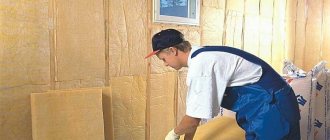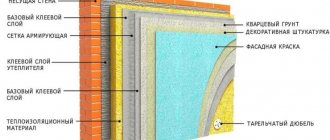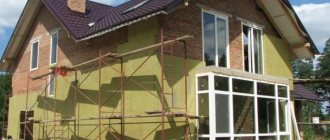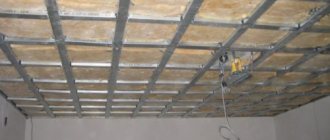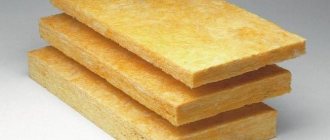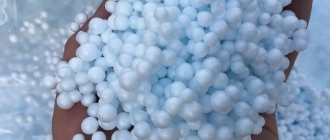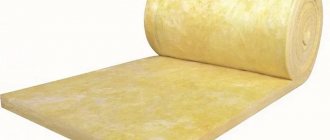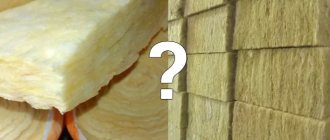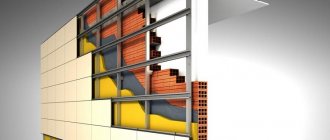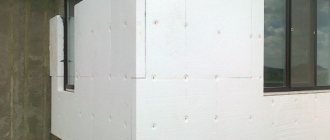Thermal insulation measures are becoming an integral part of construction work. A huge selection of insulating materials and simple installation technology contribute to this. Comfort is created not where they spend a lot of money on heating, but where they retain heat. One of the popular options is mineral wool insulation. The heat insulator has many advantages, and working with it is simple.
Mineral wool - concept and features
The word “mineral” indicates the origin of the heat insulator. It is made from natural ingredients: rocks, limestone, clay, basalt, dolomite. When they melt, fibrous material is formed, from which mineral insulation is made. There is only air between the fibers, due to which the wool has excellent heat and sound insulation characteristics.
Mineral wool has a trump card that other insulation materials cannot boast of: it is not afraid of deformation loads.
Insulating mineral wool is produced in the form of slabs and rolls. The peculiarity of slabs (mats) is that they are more rigid/dense and can keep their original shape. Rolls are suitable for floors, attic floors (they are horizontal) and for unloaded structures. Peculiarities:
- Strength from 0.08 to 0.06 kg/cm2. The difference depends on the type of heat insulator.
- Thermal conductivity coefficient is from 0.036 to 0.060 W/(m*K), depending on the density.
- Moisture absorption 6–30% when completely immersed in water.
- The density of mineral wool for wall insulation is from 35 to 100 kg/m3.
- Vapor permeability from 0.21 to 0.41 mg/(mchPa).
- Fire resistance is high. The material can withstand temperatures of 1000 degrees.
- Sound insulation from 0.7 to 0.9 Rw (dB).
- Thermal insulation material will last from 50 to 70 years.
Types of mineral plates for thermal protection
Today's building materials market is able to offer the buyer a large selection of heat-protective materials, all of which can successfully solve the problem of preserving thermal energy in the house.
When purchasing building materials, pay attention to a number of its important characteristics:
- The thermal conductivity coefficient should be as high as possible.
- Water absorption should be as low as possible.
- The density of the material affects the overall weight of the structure.
- Flammability is selected not lower than class G4.
- The service life should not be less than 25 years.
- Vapor permeability should be as high as possible.
Glass wool
This is a microfiber heat-insulating material that belongs to the class of mineral wool and is one of the popular heat insulators today. It is sold in the form of rolls and mats. In order to ensure reliable thermal insulation of brick walls, you will need a glass wool thickness of 150 mm.
The advantages of glass wool include:
- increased noise protection;
- low density and light weight of the protective structure;
- easy installation work;
- elasticity and bendability;
- low cost of work;
- compact packaging during transportation;
- resistance to biological contamination and damage by rodents.
The disadvantages include high safety requirements during work, the soft structure of the material with low load-bearing capacity and the instability of the slabs in a humid environment.
Basalt
Among the thermal insulators on the domestic building materials market, basalt wool is deservedly popular. The structure of the heat insulator consists of rock fibers from the basalt and gabbro group, which are obtained in molten form.
The advantages of this insulation include:
- High material density up to 150 kg/m3.
- Easy installation.
- Low thermal conductivity 0.032 W/m*K.
- Low moisture permeability no higher than 2%.
- Good vapor permeability 0.30 mg/(m*h*Pa).
- Highest fire resistance.
- High noise protection.
- Low indicators of biological and chemical activity.
The biggest disadvantage of basalt slabs is their high cost and high safety requirements during heat protection work; in addition, for external installation, enhanced protection is required in the form of a special waterproofing layer.
URSA insulation
This insulation from the very famous German brand Ursa Geo belongs to the mineral wool class. A universal material, perfect for insulating any surface of a residential building.
Advantage of Ursa isolator:
- non-flammable material;
- high heat-protective and noise-insulating properties;
- safe for the environment;
- moisture-resistant and bioresistant;
- reinforced fibrous structure;
- low thermal conductivity 0.033 W/m*K;
- wide permissible temperature from -60 to +220 C.
The only disadvantages include the rather significant cost of the product.
Stone
It is produced from volcanic rock by melting and dividing into fibers. The process is carried out using centrifugal/spun-drawing, blowing and windrowing. The resulting material is made loose, so it is fixed with adhesive phenol-formaldehyde resin.
Stone wool is available in different densities, but for brick walls you need to use hard mats with 176 kg/m3 and a thermal conductivity of 0.045 W/m*C.
Advantages of using stone wool to protect brick walls:
- A light weight.
- Highest insulating properties.
- Heat resistance, therefore not afraid of temperature changes.
- Under any climatic conditions, it maintains its original shape and retains its own characteristics.
- Non-flammable material.
- Good vapor permeability - 0.56 mg/m*h*Pa.
The disadvantages of this type of insulation include a strong susceptibility to damage by rodents, low environmental safety parameters due to impregnation with resins, and therefore installation work can only be carried out in a respirator and protective clothing.
Slag
To produce this insulation, slags formed during the blast furnace process are used. The thermal insulation fibers are approximately 15 mm long with a thickness of 12 microns. They are formed into slabs by pressing with a binder.
The main positive qualities of slag fiber:
- versatility, which allows its use for different types of surfaces;
- long period of operation over 50 years;
- high noise and heat insulation properties;
- low purchase cost of insulation;
- easy installation.
The disadvantages of heat-protective material include low moisture resistance, while water contacting the material forms acids, which increases the rate of corrosion on metal surfaces.
In addition, blast furnace slag, on the basis of which insulation is produced, often does not meet environmental and radiation safety requirements. Slag fiber does not tolerate temperature changes, which narrows its scope of application.
Varieties of mineral wool
Mineral wool is the general name for a thermal insulator, indicating its origin. But, there are several types of products that differ from each other. They are:
- Glass wool. It has been used for a long time, but with the advent of new analogues, it is losing relevance. When working, it is important to protect the respiratory tract, mucous membranes and skin, since the insulation releases small particles of glass.
- Slag-like. Made from blast furnace slag. Rarely used in private housing construction. Suitable for non-residential premises, warehouses or temporary structures. Capable of oxidizing metal and strongly absorbing moisture.
- Stone wool. It is made by melting rocks (gabbro-basalt). Suitable for both insulation of facades and thermal insulation inside.
- Basalt wool. They prefer to insulate a house with mineral wool using this particular heat insulator. In all respects, basalt materials are better and of higher quality, they have a longer service life, and are easy to work with.
If you need to insulate a frame house using mineral wool, then the scheme involves the use of basalt wool. It is dense, does not shrink and does not burn, which is important for safety reasons.
Types of mineral wool
Basalt
They are made from gabbra, basalt, diabasalt with admixtures of rocks, limestone, and dolomite. Basalt wool has the lowest percentage of thermal conductivity; this building material is vibration-resistant and hydrophobic, and it is also fire-resistant.
Balsat wool can be of several types, both a pliable elastic material and a fairly durable one. As a result, we have a very wide range of uses for balsate wool. Because this fiber can be used to produce products with different strengths, densities and different types of coatings.
Slag
They are made from slag, which I call blast furnace slag; it is an accompanying material for metallurgical production. Slag wool has a minimal level of thermal conductivity. Effective insulation of facades with slag wool leads to the lowest indicator of its high hygroscopicity.
It is this building material of metallurgical production - blast furnace slag - that is the material for the production of slag wool. Let us mention another disadvantage of slag wool: its low vibration resistance, as well as its very high subacidity, that is, acidity.
Pros and cons of mineral wool
Mineral wool is the most popular and effective thermal insulator for wall insulation. There are many reasons for this:
- Thermal and sound insulation is good, mineral wool is one of the best in this area, can be compared with foam plastic and polyurethane foam.
- During operation, the mineral board for wall insulation will not begin to deform.
- Environmental friendliness. Does not emit toxic substances and does not interfere with allergies.
- Light weight. The material does not heavily load the structure and foundation as a whole.
- Easy to install. Even a beginner can make thermal insulation inside and outside with his own hands.
- Not afraid of sudden temperature changes.
- Thanks to vapor permeability, the walls will breathe. This is especially important if you need to insulate frame or wooden walls with mineral wool so that the wood can also breathe.
As for the disadvantages, we can note its strong water absorption. When wet, it loses its properties. But this does not apply to all types of mineral insulation. These indicators are lower for basalt wool. But, after drying, the heat insulator is restored. Another disadvantage is that cotton wool fibers scatter in different directions during operation and can cause harm. Therefore, the technology of wall insulation requires personal protective equipment: glasses, a respirator, gloves, clothing covering the skin.
Advantages and disadvantages of application
Thermal insulators belonging to the mineral wool class are usually made from natural rock raw materials, so they have many of their advantages:
- Fire-resistant material, capable of melting at 1000 C no earlier than after 2 hours.
- High vapor permeability.
- Good soundproofing characteristics, which are provided by the fibrous structure of the material.
- Chemical resistance to a wide range of chemicals.
The disadvantages of this type of insulation for brick walls include:
- the large specific gravity makes the structure heavy; 1 m2 of such protection weighs 30 kg more than the foam system;
- insufficient rigidity and strength of the insulation;
- the cost of such thermal insulation is almost 2.5 times higher than that of polystyrene foam boards;
- increased protection of performers from the harmful effects of mineral wool is required;
- high labor costs, 20% higher than expanded polystyrene.
In what cases is it better to use mineral wool?
It is difficult to answer the question of what is better to insulate a house, mineral wool or polystyrene foam. After all, various factors are taken into account. For example, polystyrene foam is not suitable for wooden houses, since it is not vapor permeable. But, protection from moisture is better. On the other hand, it burns, is not environmentally friendly and is spoiled by rodents. Although, mineral wool weighs more and is more expensive. Such nuances are taken into account and the best option is selected.
Insulation of the walls of a wooden house from the inside is done with cotton wool, since polystyrene foam releases harmful substances when heated. In conditions of elevated temperatures, cotton wool is also better suited (sauna, bathhouse, wall near the fireplace or near the stove). The same applies to insulation in a house where an allergy sufferer lives. It is also better to insulate the roof and ceilings with cotton wool.
Subtleties of insulating a house under construction
There are several rules that help achieve maximum effect from this work when constructing a new building. A few tips will help you properly insulate your home:
- Insulation boards are installed along the entire façade of the house.
- Fastenings in the form of an anchor are drilled into the wall. They are necessary to securely hold the material.
- The slab is threaded onto an anchor. Special fasteners are locked to the plate with clamps.
- Above the insulation layer, a brick wall is constructed, intended for facing purposes.
- To grout the joints, use a solution of sand and cement or use beautiful plaster.
List of tools and materials
To insulate a house with mineral wool, it is enough to buy the necessary arsenal of tools, consumables, study the instructions and bring everything to life. During the work you will need:
- Scaffolding. Working with a ladder is inconvenient. It is better to rent forests.
- Construction and water level. Ideal if you have a laser level.
- Hammer with extension.
- Wood saw.
- Narrow and wide spatula, grater.
- Container for mixing the solution.
- Construction mixer.
- Hammer.
- Roulette.
Installation of mineral wool requires the following consumables:
- Deep penetration primer.
- Reinforcing fabric mesh and corners.
- Adhesive composition and dowels for mounting mineral wool on the wall.
- Decorative plaster and paint.
- Cornices.
Everything is ready to insulate the outside with mineral wool.
Costs of raw materials and services
Material costs are determined by the insulation area and depend on the size and cost of the slabs. With a total insulation area of 109.9 m2, a thickness of the slab layer of 0.1 m, the volume of the heat insulator will be 11 m3.
Since most insulation is sold in m3, knowing its cost, you can determine the total cost of purchasing slabs:
- Basalt wool, 1500 rub/m3, total 16500 rub.
- Mineral wool, 1070 rubles/m3, total 11770 rubles.
- TechnoNIKOL basalt wool, 2270 rub./m3, total 24970 rub.
- Glass wool Isover Warm House, 1250 RUR/m3, total 13740 RUR.
- Stone wool Mat Teploroll, 1280 RUR/m3, total 14080 RUR.
- Slag wool, 860 rub./m3, total 9640 rub.
- Ursa GEO Facade, 975 rub./m3, total 10,725 rub.
The cost of work on thermal insulation of a brick house depends on the following factors: the type of materials used, the area of thermal insulation of wall structures, the height of the house, transport interchange in the construction area, finishing method, technical condition of the surface, period of year.
Average prices by region of Russia for thermal insulation of brick walls:
- thermal insulation with mineral wool on glue, 360 RUR/m2;
- fiberglass reinforcement and glue treatment, 410 RUR/m2;
- primer work, 60 rub./m2;
- performing decorative plaster, 380 RUR/m2;
- thermal insulation with mineral wool on a wooden frame, 870 rub./m2.
If you are interested in how and with what you can insulate brick walls from the inside and outside, take a look at this section.
How to properly insulate a house with mineral wool with your own hands step by step
We will consider the classic option: insulating the outside of a private house with mineral wool using plaster. The method is called wet. The work is carried out at a certain temperature range from +5 to 30 degrees. But, there is an option to insulate the walls with mineral wool from the outside in frost (up to -10) using anti-frost additives.
The whole process is divided into several stages:
- Preparatory work.
- Padding.
- Fastening mineral wool to the wall.
- Reinforcement with dowels.
- Sticking metal corners to façade corners and slopes.
- Creation of a reinforcing layer.
- Priming and creating the finishing layer.
The façade structure, or pie as it is called, will consist of several layers. Namely: wall, adhesive solution, mineral wool, umbrella dowels, second layer of glue, reinforced mesh, glue, finishing.
Preparing the walls
The technology of insulating walls with mineral wool requires careful preparation of the surface. The main requirement is evenness. A deviation of 15 mm per floor is allowed. Cracks in the walls are sealed so that there are no cold bridges. When insulating a brick wall from the outside with mineral wool, it is necessary to remove excess mortar from the seams, if any remains. The same applies to interfering protruding elements.
If the wall is too old, it can be primed and plastered using reinforcing mesh. Further work is carried out a week later. During this period, the plaster will completely dry.
Installation stages
Insulation of walls from the outside with mineral wool under plaster begins with fixing the starting strip (profile) at the bottom of the walls. The width of the plank is identical to the thickness of the wool, since the slabs will be inserted and rested on the profile. To align the plinth level, you need a level, ideally a laser one.
Then you can install the first row of slabs. First they are fixed with glue. It is applied to the back side of the slabs either in spots or in a continuous layer (toothed base method). The second option is used for perfectly smooth walls. The thickness of the adhesive layer is 3 mm. The plate is installed in its place and pressed with hands. It levels out. Then the second mineral wool slab is glued. It must be remembered that the second row is done with a dressing of 10 cm, so that the seams are not located opposite each other, but overlap one another. For convenient joining, the mineral wool can be trimmed.
The next stage is the installation of anchors or dowels. But, it is important to leave the wall until the glue dries for 2 days. Dowels are inserted into holes drilled with a hammer drill. Then a core with an umbrella is hammered into them to hold the slab. For 1 m2 you will need 5 dowels.
Now all that remains is to make the reinforcing layer. To do this, a layer of glue is applied, a reinforcing mesh is embedded in it and more glue is applied. The mesh should be in the thickness of the glue and not come into contact with the mini-slab. The mesh is mounted without sagging, with an overlap of 10 cm. The mesh is rolled across the width of the door and window opening.
At this point, the insulation of the outside walls of a wooden house with mineral wool is almost complete. All that remains is to wait for the glue to dry and start finishing the exterior.
Facade surface preparation
Before starting to work with insulation and plaster, it is necessary to clean the surface of the walls from oil stains and dirt and level them. According to technology, all metal elements that may rust must be removed from the walls outside. If these are strategically important metal elements, then it is necessary to ensure the flow of oxygen under the plaster, i.e. this immediately excludes the use of acrylic-based plaster.
The insulation material must have low thermal conductivity. Therefore, mineral wool, namely its variety with a density of 140 kg/m², is ideal.
If there are remnants of the old coating on the walls, be it paint, plaster or anything else, then insulation cannot be placed under the plaster.
Before starting insulation, it is worth using sags to mark the boundaries of the zones. Sags are strong nylon cords pulled between the reinforcement pins (these pins must then be removed, so do not drive them in too tightly), fixed at a designated point in a vertical, horizontal position and diagonally.
Sags are installed to assess the geometry of the wall
Once the sags are in place, it becomes much easier to evaluate the wall geometry. The sags must be attached so that they retreat at least 1 cm from the mineral wool. After the wall is marked, you can begin installing the guide profiles.
The principle of insulation under siding (ventilated facade)
Knowing the fact that mineral wool is vulnerable to moisture, it needs to be used. Namely, to ensure the removal of this moisture from the material. To do this, it is better to resort to the technology of creating a ventilated facade. This is the insulation of a wooden house from the outside with mineral wool under the siding. Frame technology is used here, which creates a ventilation gap where there is air. The cotton wool will dry out and restore its functions. This is the best option if you need to insulate a wooden house with mineral wool.
The process is as follows:
- The walls are being cleaned.
- The sheathing is installed. It can be made of wood or metal. The distance between the planks is equal to the width of the mineral wool. You can make it 0.5 cm smaller to fit the cotton tightly.
- A vapor barrier film is fixed with an overlap of 10 cm.
- The insulation is placed in its place. The boards must fit tightly.
- Creating a counter-lattice. This will create the required gap. In addition, siding will be attached to it.
- All that remains is to attach the waterproofing and install the siding.
The insulation of the walls outside with mineral wool under the siding has been completed.
Roof insulation
Mineral wool is not far behind in its relevance and convenience and in roof insulation. It is environmentally friendly, made of non-flammable material, soundproof. To prevent moisture from accumulating in it, an insulating film is included in the composition.
The main mistakes in roof insulation.
- The chosen size of the canvas is not correct; it is better to take a margin of 10-50 mm more than the measured one, so as not to allow cold to pass through the gaps.
- The terms chosen are not correct; it is advisable to discard materials whose shelf life is less than 10 years.
- Do not forget that you need to use a material of low rigidity to avoid cold bridges.
The final stage is decorative finishing
Insulation under siding
After waiting for the reinforced layer to dry completely, you can begin finishing the walls. It is advisable to go over the surface with a primer before this to improve adhesion, that is, adhesion to the surface. You can choose various materials as a decorative coating:
- decorative putty;
- bark beetle;
- siding;
- clapboard
These are not all the materials that can be used to decorate your façade. Naturally, the choice of decorative coating depends on your desire and availability of funds. That's all, now your home is fully insulated and prepared for the harsh winter conditions. By insulating your home with mineral wool, you can not only make it warmer, but also save on heating costs. But you can insulate a house not only from the outside, but also from the inside . Let's find out how this can be done.
Insulation from the inside with mineral wool - mistakes with serious consequences
Insulation from the inside with mineral wool is similar to sabotage in order to cause maximum damage to the structure and people. Standards require that experts recommend thermal insulation only on the outside of the building.
But insulation from the inside is an extreme necessary measure, and it must be carried out according to certain rules. Can this be done using mineral wool with special measures to protect structures?
Let's decide in order - how to properly insulate, how mineral wool should be used, what common mistakes and opinions exist in this regard.
Lack of insulation from the inside - freezing
When insulated from the inside, not only with mineral wool, but also with any heat insulator, the wall is protected from heat, so its temperature decreases.
Moreover, with a sufficiently large amount of insulation, the wall can freeze through. Freezing a structure is always bad, because for any material there is a finite number of freezing cycles before its destruction. It’s even worse if the wall freezes while wet. In this case it will be so.
Humidification, dew formation
The dew point - the temperature at which dew falls from the air - will be located directly on the wall.
More precisely, condensation may begin to fall in the insulation, but the cold surface of the wall will also condense water on itself. And there will be a lot of water, it will also flow onto the wall from the insulation, especially if you use mineral wool.
A wet wall will grow excellent “greasy” mold and large colonies of putrefactive microorganisms. All this will be located indoors, spreading from the wet collapsing wall along the ceiling, floors... Residents will need means of rescue.
Finally, when insulating from the inside, the heat insulation and finishing will take up part of the usable space. The usable area of the room will decrease by about a square meter. It's a lot.
The above disadvantages can be circumvented and leveled out (except for eating up the usable area). But only if mineral wool is not used for internal insulation.
Mineral wool is moisturized and accumulates water
Mineral wool is not suitable for insulation from the inside, even in forced situations, due to its properties. This insulation perfectly allows water vapor to pass through itself and can accumulate water inside, becoming simply wet.
It is clear that when insulating from the inside, the insulation will become wet due to the dew point in it and the lack of ventilation. The consequences are known.
The material consists of tiny fibers of basalt or other minerals. It is also made from blast furnace slag and silicates (glass wool), these samples are cheaper. To bind the fibers together, phenol-formaldehyde resins are used, the same as in the production of chipboard.
Mineral wool owes its good thermal insulation to the air trapped between many interwoven fibers. If the air is replaced by water, at least partially, then the required thermal insulation qualities will disappear.
Even a slight increase in humidity (by 2%) of this insulation leads to a significant decrease (up to 8%) of its thermal insulation properties.
Mineral wool is harmful indoors
Some of the fibers are microscopic in size and are carcinogenic (cause cancer of the respiratory system). Resins evaporate, and when heated - significantly, they are harmful substances to health. In principle, it is not prohibited to use mineral wool indoors.
But it must be reliably isolated from the living space; it is advisable that the fumes from it do not get inside the house, but are discharged outside. Dispersing mineral wool fibers around the house (apartment) is not permissible. Some experts, due to potential health hazards, generally recommend using mineral wool only outdoors.
Work with mineral wool should be carried out only with personal protective equipment.
Why do they want to insulate from the inside?
Why is the desire to insulate from the inside great?
- It seems that this is easier and cheaper to do than from the outside (although in the end it is much more profitable to insulate from the outside).
- Many people want to use mineral wool - at first glance it is not expensive and it is not difficult to do without wet processes (in fact, it is often easier and cheaper to insulate with other insulation materials).
- In addition, you can also read on the Internet how to insulate the inside with mineral wool (the information is often incorrect).
Which methods are not correct?
Several common opinions about creating internal thermal insulation.
- Mineral wool needs to be protected with a vapor barrier on all sides - and the problem of moisture is solved.
Stretching plastic film directly over the wall and then over mineral wool does not solve the moisture problem. The owners can subsequently cut the film and, in endless surprise, drain the water from the insulation. Steam will still penetrate behind the film, and even through it, and condense there due to the temperature difference - after all, there is no ventilation. The wall will be moistened under the polyethylene.
Build a plasterboard partition and a waterproofing layer underneath it. The wall will get wet, but it will not get into the room.
All in all…. Why do all this if the insulation gets wet and does not perform its functions?
We build a partition with mineral wool at a distance of 5 cm from the wall. We make ventilation along this gap - we supply air through the holes at the bottom and exhaust it out through the top ones.
The superproject has the right to life as a fiction without economic meaning - a large consumption of space, materials, and a very unprofitable option for internal insulation.
- There are even recommendations to dry the wall and insulation with electricity. All this is of course interesting, but it is better to do without such solutions at all. It is, in principle, possible to insulate from the inside; you can find out how to do this on this resource...
How is mineral wool used?
Mineral wool can be used to insulate all structures of a house, except the foundation. The classic application is thermal insulation of the roof above the attic floor. There, mineral wool is placed between the rafters; it is this insulation that is best combined with wood - it does not interfere with the “breathing” of the wood.
You can also insulate walls made of any materials outside the building. Wherever mineral wool is used as insulation, its ventilation must be organized. More precisely, a ventilation gap should be made above the layer, on the side of low partial pressure.
Fastening technology
Do-it-yourself fastening of mineral wool slabs to a brick wall, lathing and under clapboard or brick must be done correctly, in a certain sequence and in compliance with all technologies. After calculating the required amount of material and determining the optimal type, you can purchase mineral wool.
Laying mineral wool on the walls outside the building can be done in the following ways:
- well system;
- wet method;
- ventilated facade.
The “well” system involves an event in which mineral wool must be laid inside the wall in the gap and between the bricks. It is better to attach insulation to a wooden surface using a ventilated facade. In this case, a frame is installed along the entire perimeter of the structure. Laying the insulation is not difficult even for an inexperienced craftsman, and fastening can be done with dowels “fungi” or glue.
Step-by-step scheme for insulating a wall using mineral wool using the wet method:
- the surface is cleaned of dust and dirt, after which it is necessary to remove depressions and irregularities from it;
- the basement cornice is attached;
- using a special composition, a layer of mineral wool is glued;
- for reliability, the insulation is fixed with dowels;
- a reinforcing layer is applied;
- the surface is properly primed and plastered;
- Can be painted in any color you like.
If for some reason the wet method is not suitable for the master, you can install the mineral wool step by step using a ventilated façade.
- The wall is impregnated with an antiseptic. If there is rot, it is worth using special compounds.
- Remove slopes and platbands.
- The surface is dried throughout the day.
- Lay the membrane layer. In the case of a perfectly flat surface, it may not be needed.
- Self-tapping screws are used to fix wooden slats, the thickness of which must correspond to the dimensions of the mineral wool. The distance between the slats should be 20 mm less than the width of the insulation.
- Cotton wool is placed in the sheathing.
- Fix the material to protect it from water and wind. Fastening can be done using a stapler.
- To create a ventilated gap, counter battens are mounted on top of the sheathing. This type of cladding should be fixed at a distance of 60 mm from the insulating layer.
Upon completion of the above work, new trim and slopes can be installed.
Common mistakes when laying material
- Lack of site preparation before work. Some workers do not first protect windows, doors, and furniture from dust and dirt, after which they become dirty and deformed.
- Ignoring surface preparation before insulation. The presence of defects, unevenness of plaster, mold, efflorescence must be eliminated before insulation begins.
- There are no starting bars that take the load from the mass of the material.
- Incorrect order of installation of slabs. The best order for laying mineral wool is considered to be a checkerboard pattern. In this case, the fixation should be tight.
- Errors in applying the adhesive composition. Such a nuisance may result in bending of the insulation or marking its outline on the finished insulated façade.
- Lack of fastening.
- No weather protection layer. This moment can lead to slow drying of the walls, and the thermal insulation itself will be ineffective.
- Lack of filling of seams at the border of the insulation. As a result, cold bridges form in the wall.
- Ignoring the use of a primer before applying decorative plaster. The result of such an oversight can be improper gluing of the plaster, surface roughness, and the presence of gray gaps.
In order to save on heating in winter, provide housing with optimal temperature conditions in the summer, prevent the formation of mold and mildew, and also soundproof the building, you can use insulation. For this purpose, many craftsmen use mineral wool, which not only has high performance qualities, but is also characterized by an affordable cost.
Mineral wool is a popular, safe material that almost anyone can use to insulate a building.
You can learn how to properly insulate the facade of a house with mineral wool from the video below.
Material calculation
The amount of insulation directly depends on the area and is calculated simply - it is multiplied by the number of layers. However, here it is important not to make a mistake in the thickness - it is not economically profitable to increase it too much, on the contrary, reduce it too much - the wall will freeze, and all the work will be in vain. Instead of some kind of theoretical calculations, practical experience of use is more important here - it will be more effective to collect information about already insulated buildings in your region and experience of further operation. Then analyze and draw conclusions for yourself. After all, the correct thickness of mineral wool for insulation is selected additionally, to the finished wall, which itself has protective properties - albeit insufficient, but they exist.
Reinforcement of corners and facades
Reinforcement of corners
To give the slabs impact resistance and protect them from mechanical damage, all corners are reinforced with a special reinforced PVC profile with mesh. To do this, a special reinforcing mixture must be applied to all corners of the building with a layer of 2 mm. Its width should be slightly larger than the width of the profile with mesh. Place the corner on the corner and press it into the solution using a smooth spatula. Gently iron the mesh so that it sinks evenly into the solution. After all the corners have been made, you need to wait 1 day and begin reinforcing the entire surface of the facade slabs.
It is not recommended to perform such work in direct sunlight. To reinforce the insulation, you will need to buy a special fiberglass mesh. Apply a special reinforcement mixture to the slabs. Roll out a roll of reinforcing mesh and secure its end to the top of the insulated wall. Sink the mesh into the solution, gradually moving down the wall. Cut off the excess and continue the process until you have reinforced all the walls. To avoid cracking, overlap one mesh over another by at least 100 mm. The last stage of reinforcement will be applying a covering layer of 1–2 mm solution to the mesh using the wet-on-wet method. It remains to wait 2-3 days for everything to dry.
How to choose?
If you decide to insulate your home, you need to know a few rules to choose the right material.
To do this, it is important to take into account the characteristics of the structure where the work will be carried out: is it residential or commercial, what material was used during construction
Experts recommend calculating in advance the density of mineral wool that will suit the task. It is worth noting that often errors occur not due to poor quality of the material, which happens quite rarely, but precisely due to improper use. Therefore, before purchasing, it is better to study all the technical characteristics and features of using a particular category of mineral wool.
Slabs with increased density are in great demand - they have minimal moisture absorption rates, so this option is best suited for finishing facades
To insulate the room, you can pay attention to mats - this is a rolled material, the design of which is quite convenient
It is important to consider the material from which the walls are made: if they are wooden, the density should not be high, because the surface must breathe, otherwise it will become moldy. There is an unspoken rule that for thin walls it is necessary to take a thick layer of thermal insulation
Let's compare two types of insulation - mineral wool versus polystyrene foam
Polystyrene foam (expanded polystyrene) and mineral wool are the most popular thermal insulation materials today. Each of them has its own advantages and disadvantages, and has its own scope of application. Foam boards are recommended for use for external thermal insulation of walls, mineral wool for roof insulation and as a heat insulator when installing curtain facades. However, there is an opinion that these materials are interchangeable. Is it so? Let's try to figure it out.
Foam plastic: pros, cons and application features
Polystyrene foam - foamed plastic material - has an extremely low thermal conductivity coefficient. This is the best thermal insulator on the planet. It is estimated that a foam plastic board 10 cm thick in terms of heat-shielding properties replaces 40 cm of wood, 60 cm of aerated concrete, 90 cm of expanded clay concrete, 150 cm of hollow brick, 400 cm of reinforced concrete. Foam plastic also wins in comparison with mineral wool: 10 cm of polystyrene foam is equivalent in thermal protection to 16 cm of mineral wool. But polystyrene foam cannot protect you from noise. It is no sound insulator.
As for vapor permeability, this characteristic varies depending on the density of the material. Low-density foam is close to cotton wool in terms of vapor permeability, while high-density foam allows steam to pass through, although with difficulty, so it can be used to insulate only very dense walls.
There is no consensus regarding the environmental friendliness of expanded polystyrene. Disputes over the toxicity of polystyrene have lasted for decades. Soviet scientists also proved that under certain conditions this material is capable of releasing toxic styrene into the environment. However, the results of modern laboratory studies indicate that high-quality polystyrene foam is absolutely harmless. The tiny amount of styrene that it releases has no effect on the human body. Advice: before purchasing, be sure to check the residual styrene content - the value of this indicator should be in the range of 0.01-0.05%.
Its service life also depends on the quality of the foam. The most durable are the pressless brands PSB and PSB-S. They do not change their properties for 10-40 years. Extrusion lasts even longer - up to 80 years. The biggest problem with polystyrene foam is its high flammability. Styrene foam can catch fire with just a spark. When exposed to fire, it melts and emits black toxic smoke. To solve this problem, special additives began to be introduced into foam plastics - non-flammable and flame-extinguishing additives. This is how a new type of expanded polystyrene appeared - self-extinguishing brand PSB-S. This material cannot be ignited by a spark, but it has no protection from fire. Important: all types of polystyrene foam must be used exclusively for external insulation.
Mineral wool: main properties, advantages and disadvantages
Mineral (“stone”) wool is a fibrous material obtained by melting igneous rocks. The advantages of mineral wool are predetermined by the properties of the raw materials.
The undoubted advantage of this mineral insulation is fire resistance. The melting point of mineral wool is 800C. It not only retains all its properties in the event of a fire, but also prevents the spread of fire. Mineral wool ranks second in terms of thermal insulation properties after foam plastic, but at the same time it is highly hygroscopic - in a humid environment its heat-shielding properties deteriorate significantly. But unlike polystyrene foam, mineral wool does not interfere with the passage of steam - the condensate that falls freely passes through its fibrous structure and evaporates from the surface.
Insulation materials. How to choose a “fur coat” for your home?
All insulation materials are divided into two categories:
- Organic.
- Inorganic.
The first group is more numerous. It includes chemical industry products such as polystyrene foam and penoplex, as well as natural ecowool insulation.
When answering the question of how to properly insulate a facade, you must first consider the physical properties of the materials offered on the market.
Foam plastic and penoplex
Foamed polymers, which include foam, by definition cannot be called durable. The aging process, characteristic of any plastic, goes much faster here. The reason for this is the huge contact area of polystyrene with the air contained in its structure. Therefore, manufacturers’ statements about a 50-year and even more so a 100-year service life cannot be considered serious and objective. This type of insulation will last you no more than 20 years, after which it will have to be replaced.
Penoplex is the same polystyrene foam, but produced by extrusion (at elevated temperature and pressure). It is more durable and stronger than ordinary polystyrene foam, but still does not reach the 50 years of operation promised by advertising.
If you can somehow come to terms with the relatively short service life of polystyrene foam, then you can argue with statements about its “super environmental friendliness”. As this insulation ages, it decomposes, releasing toxic styrene. Although its concentration is low, and the process of diffusion into living spaces through walls is difficult, nevertheless, this fact casts doubt on the cheerful statements of the manufacturers.
The second incorrect statement regarding polystyrene foam is its excellent soundproofing qualities. This material is quite rigid and at the same time very light. This combination of properties is not typical for effective sound insulators. Therefore, insulating the facade with foam plastic does not provide a noise-reducing effect.
Insulation of the facade with foam plastic - saves heat, does not absorb sound
The undoubted positive qualities of foam plastic and penoplex are ease of installation and ease of finishing. Due to the rigid structure of the insulation, plaster can be applied to it or light ceramic tiles can be glued onto it.
Speaking about facade insulation with polystyrene foam, you should pay attention to thermal panels with clinker tiles. This composite material does not require finishing
It is obtained by foaming polystyrene in the same form as the facing tile. This ensures strong adhesion of the insulation to the exterior finish.
More expensive thermal panels are produced using polyurethane foam instead of polystyrene foam. Installation of composite insulating cladding is carried out using a special glue, joining the panels with serrated protrusions.
Ecowool
The direct opposite of polystyrene foam and other foamed polymers. It is made from natural cellulose, so it deserves the name of environmentally friendly insulation. Ecowool contains minerals - borax and boric acid. They are safe for health and are designed to protect cellulose from rotting, fire and rodents.
Ecowool has high sound-absorbing characteristics. Its loose structure dampens acoustic vibrations well. The breathability of this insulation corresponds to that of natural wood.
Take this fact into account when deciding how best to insulate the facade
The disadvantage of ecowool is the impossibility of applying it to the facade using a dry method. Therefore, most often wet technology is used for insulation. It consists of spraying damp ecowool onto the walls. When dry, it forms a dense and warm shell that adheres well to a vertical surface. The finishing finish for ecowool is plaster, magnesite board or blockhouse.
Wet method of insulation with ecowool
The dry insulation method is only suitable for frame buildings. They have cavities between the outer and inner lining, into which ecowool is blown.
Mineral wool and glass wool
The second group of materials for insulation is represented by basalt mineral wool and glass wool. Glass wool insulation is rarely used today. During installation, it releases tiny particles of glass that enter the respiratory system and cause harm to the body. Mineral wool is safer in this regard.
It should be noted that loose roll insulation made of mineral wool is not suitable for the facade. Therefore, in practice, semi-rigid or rigid slabs (density from 90 to 200 kg/m3) are used. They are fixed to the walls using construction adhesive and disc dowels.
Facade cladding with rigid mineral wool slab
When deciding whether polystyrene foam or mineral wool is better for insulating a house, many owners prefer the more durable basalt material.
“Well” type insulation
Only used during complete renovation or construction. A layer of mineral wool is placed directly inside the wall, which consists of three parts:
- main masonry;
- insulation;
- sand-lime brick or concrete blocks.
Work on insulating the facade using the “well” method should be carried out in dry weather at an air temperature of up to +30C and its humidity not exceeding 85%. If you need to take a break for a long time during the process, then cover the insulated area with heat-resistant fabric. This will isolate the mineral wool from external influences.
In the case of a panel house, the insulation is placed between the joints of the slabs. Mineral wool is placed in the cracks and covered on top with mastic that is resistant to moisture and ultraviolet rays. It can be a polysulfide polymer or silicone liquid rubber.
This option of insulation and sealing is used for wide seams that are impractical to fill with construction foam.
Installation of insulation for a frame structure
The technology for insulating a frame house is generally similar to the process of insulating wooden houses described above.
On the interior walls, chipboard is attached to the frame. They are joined along the beams and beams of the strapping. Then the vapor barrier is fixed and drywall or lining is installed.
Installation of mineral wool
Mineral wool slabs are laid on external wall surfaces. The number of layers depends on the region in which the house is located. The joints of the previous layer are covered with the next row of insulation. First, at the bottom of the wall, it is necessary to fix the galvanized cornice using dowels: it will help the insulation boards lie flat and protect the building from rodents and insects.
You can fix the mineral wool on the wall using a special adhesive solution. It is applied to the back side of the mat, slab or roll, which is then applied from bottom to top, easily pressing it against the wall.
You can attach the heat insulator with dowel-nails “umbrellas”. It is necessary to control that the material does not move apart when punched. Its surface is smoothed with sanding brushes. A primer mixture is applied to the mineral wool mats or slabs.
Creating an air gap and finishing
The sheathing will help retain the heat insulation layer. It will also create a ventilation gap between the windproof membrane and the outer skin. Chipboard is installed on the sheathing. Then the cladding (for example, siding or lining) is installed.
Thus, mineral wool slabs placed between the frame posts will be sewn between the chipboard slabs from the outside and inside.

